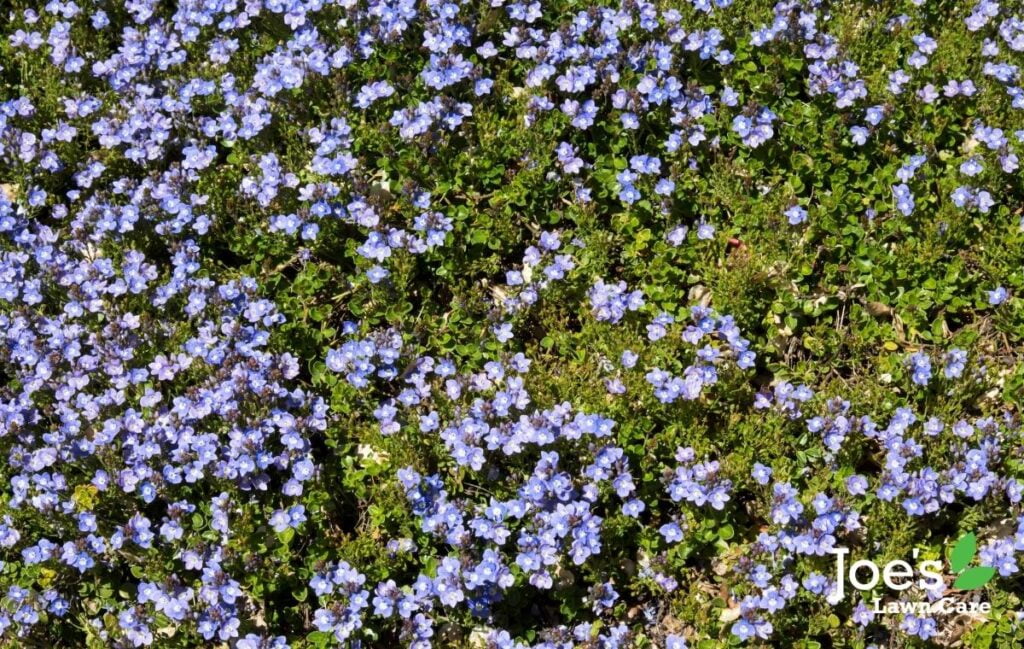Lawn Problem Spotlight: Speedwell
For some people, seeing speedwell creep across their lawns and adorning their garden with dainty flowers at the start of summer is nothing less than a tonic for tired eyes – and we get it. The pinks and purples and blues are a sight to behold. The problem is, well, speedwell is one of the most invasive weeds from Norfolk to Nottingham; one that’s able to put down roots incredibly quickly and then start taking over your lawn and borders.
Here’s everything you need to know about Speedwell:

What is the history of Speedwell?
Having been introduced to our little island in the early 1800s, Speedwell went from being a much-wanted rock plant to a cheerful addition to any flower-filled gardens to an invasive weed known to quickly take over lawns and borders.
What does Speedwell look like?
As with most kinds of plants, there are a few different species of Speedwell, but the most common is Slender Speedwell, a low-growing plant that boasts long blue flowers that come into bloom throughout spring. But because of its low-growing qualities, this species can easily form dense patches throughout your lawn.
The other common type of speedwell, at least in gardens, is the ivy-leaved speedwell that also loves running riot in lawns and borders, especially in moist and shady places.
What problems does Speedwell cause?
This perennial plant has a real thing for creeping across your lawn, rooting as it goes to create a thick carpet of weeds. Pretty, but still weeds. But what makes them particularly fast spreaders is the way they do it. From having their stems scattered by your lawn mower to being added to your compost pile and then spread before they have completely decomposed, to your grass not being healthy enough to hold off any advancing speedwell, this weed was born to spread out.
How to control any signs of Speedwell in your lawn?
As with almost every area of weed control, there are two ways to tackle your Speedwell problem: the cultural way and the chemical way. Of course, we’d urge you to always try using organic means first before bringing in chemical controls as a backup. Here’s how:
Cultural control: The best form of defense is offense, which is why your focus should always be on growing thick, healthy grass that’s able to stop the spread of speedwell by simply crowding it out. That said, there are other cultural methods that will help you. For instance, when you mow your lawn, try raising your mower bar as slightly longer grass will help smother the weed. Alternatively, a bout of aeration and/or scarification may prove beneficial, while mulching any bare soil to smother the weeds will also help you tackle them en masse.
Chemical control: When it comes to controlling speedwell with chemicals, make sure you are using weedkiller to the minimum and in a targeted way or you might find you damage more underlying plant roots than you wanted to. It’s also super-important to note that our range of professional herbicides will always be more effective than those available for amateur gardeners.
What if Speedwell has made it to your borders?
There’s a reason Speedwell got its name and that’s the veracity in which it can spread across your lawn and into your beds. If this is the case with your lawn, the best thing you can do is spot treat any areas of infestation using the non-selective weedkiller glyphosate, but with an incredible level of care to avoid any and all contact with your other flowers and plants.
The trick is timing, in which your best bet is to carefully apply glyphosate between June and September for the most effective results. Then, once you’ve applied your weedkiller, leave your Speedwell for up to a month, which is how long it can take your weedkiller to start doing it’s job, after which you can pull on your gardening gloves and remove this dead plant.

The Takeaway
Speedwell is a survivor that can set up camp in almost every kind of soil, but lives its best life in moist, shady, nutrient-rich soils, especially if you mow your grass short. What’s more, this weed can spread easily, so it’s important to remove any clippings when mowing the lawn or else the spread will continue. And while a decent scarification session may prove beneficial in reducing numbers, you might need to get a professional-level chemical weed killer to halt it properly. That’s where we come in.
Thanks for reading our lawn problem spotlight on speedwell. For more lawn care tips and tricks, follow us on Facebook and Instagram.





